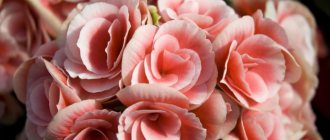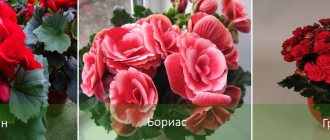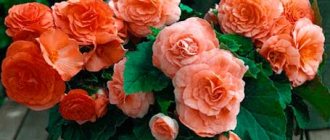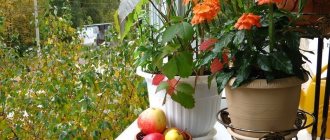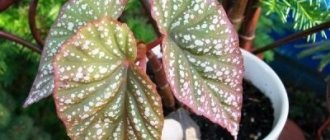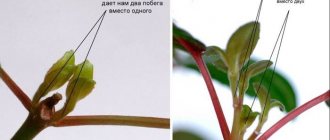Begonia is an exotic ornamental plant with beautiful flowers and leaves. In the tropics and subtropics, it independently forms herbaceous thickets on the lower tiers of forests; some species are attached by roots to the bark of trees. The temperate climate is not very favorable for this heat-loving crop, so in winter it is usually grown on window sills or balconies. Tuberous varieties often spend the summer outside, and during the cold season they “fall asleep” and remain dormant until spring. These flowers are propagated mainly by vegetative means, since doing it from seeds is much longer and more difficult. Read on to learn how to root begonia from a cutting, leaf or tuber.
Description of the plant
Begonia is a real treasure for the gardener . Among its species you can find both beautifully flowering and deciduous ornamental plants. The diversity is so wide that it is quite difficult to describe begonia as a separate plant.
Drop-shaped, round, elongated, maple leaf or heart-shaped leaves of deciduous begonia are stunning in their shape. In addition, they have a very diverse color: red, black-red, silver, speckled, with complex patterns, pink-green, purple and gray leaves.
Beautifully flowering species of begonias amaze with no less diversity . During the flowering period, the bushes are densely strewn with simple and rose-shaped complex flowers. Yellow, white, cream, orange, red, pink and purple petal shades can be found among the variety of varieties of this plant.
Reference. Since the 17th century, this plant has been actively used in indoor and garden floriculture. There are more than 1000 species in nature, whose geographical homeland is Africa, Asia, and India.
Botanical features of evergreen begonia
The discoverer of begonia, who compiled a detailed botanical description of the genus, was Charles Plumier. He was a monk who traveled extensively to collect and study wild crops. In the middle of the 17th century, he arrived in the Antilles, where he met this lushly blooming fragrant flower. The name of the culture was given in honor of the governor of Haiti, Begon.
Western Africa is considered the homeland of Begonia. There is a hypothesis that from this hot country begonia migrated to America and Asia. However, even today a third of the total variety of begonia species is actively blooming in Africa.
Ever-flowering begonia or Begonia semperflorens is the largest representative of the Begoniaceae family. The genus has more than 1000 subspecies, the natural habitat of which is mountain slopes, tropical forests and subtropics. Begonias are found mainly in the southern part of America. But many species grow in the mountains of India, the Malay Archipelago, and also in the Himalayas.
Considering the enormous popularity of begonia in home floriculture, almost 2 thousand hybrid species and varieties have been bred. They differ in shape, color of inflorescences and leaves.
The following are considered to be the general distinctive features of the genus of ever-flowering begonias:
- Begonia is a medium-sized bushy crop with straight shoots that can grow up to 55-60 cm in height.
- Mature plants change slightly, and straight shoots take on an ampelous shape.
- Begonia evergreen flowers can be large or medium. The diameter of the open bud is 2.5-5 cm.
- Ever-blooming begonia leaves are round in shape, slightly pubescent along the perimeter. The size of each leaf varies from 4 to 6 cm, the color can be different - light or dark green, less often with a red tint.
- Flowers are tied in groups into inflorescences, quickly wither, constantly being replaced by new ones. With proper care they bloom continuously.
How to propagate - methods
Among such an abundance of species, indeed, every flower lover will find a plant he likes, most likely even more than one. Therefore, let’s consider options for how to propagate begonia at home:
All flowering (not to be confused with beautifully flowering) species reproduce
by seeds The process is long and complex. It is quite possible to plant and grow indoor begonia in this way, but at the initial stage you will have to take care of it like you would a baby.- By dividing the tubers, tuberous begonia species can be propagated.
- Leaf cuttings and leaf fragments . Yes, begonia is extremely prone to reproduction, so even a piece of a leaf can produce offspring.
- Stem cuttings , that is, the cutting method familiar to all gardeners. This method gives quick results with fairly simple technology. The easiest and fastest method of propagation, which is suitable for almost any type of this plant.
Algorithm for propagating begonia by leaf at home
Experienced flower growers are well aware of flower propagation. Nevertheless, for each individual subspecies of begonia there are a number of nuances of reproduction at home. Leaf propagation is most relevant for those varieties that grow without a stem and cannot be propagated by cuttings, including climbing begonias.
First of all, you need to choose a healthy and large leaf. Carefully, using a sterile sharp instrument, separate it from the stem, not forgetting to treat the cut area with crushed activated carbon.
The sheet itself must be laid out on a flat and clean surface, preferably on glass. After which, from the middle (largest) core to the edges, the sheet is cut into triangles
It is important that each such triangle has several cores. From one large leaf you can prepare more than 10 fragments suitable for propagation:
- Each triangle should be placed in a separate container.
- The chopped parts of the leaf are laid out on prepared soil (wet sand is best suited for these purposes).
- The edges of the triangles can be sprinkled with sand, or you can stick the lower core into the sand to a depth of up to a centimeter - both methods are quite good.
- The most important point is to cover the planting material with film or cellophane, thus creating a mini-greenhouse.
- It is necessary to maintain stable humidity inside by periodically spraying the leaves with a spray bottle.
One of the options for proper preparation of planting material is shown in the photo.
After a month and a half, when the first leaves appear on the young plant, you can gradually open the greenhouse for 5-10 minutes, accustoming the planting material to a normal environment. Every day it is necessary to increase the time of airing the plant. If everything is done correctly, then within three months from the moment of planting the leaves will take root and will be suitable for transplanting into separate cups.
It will also be interesting: Reproduction of gloxinia - leaves, seeds, at home?
General rules for cuttings
In addition to step-by-step instructions for the process, there are rules and conditions that must be taken into account to obtain a good result:
- When and how is the best time to take cuttings? For indoor specimens, the best time is the month of March. Plants planted in spring develop in harmony with natural biorhythms. If your begonia spends the summer in open ground, you can take cuttings in the summer.
- The temperature required for successful rooting is 20-25 degrees. This is very important; roots are unlikely to form in an insufficiently warm atmosphere.
- Humidity also plays a big role in the cutting process. Therefore, to ensure a guaranteed result, a mini-greenhouse is made for the cuttings, simply covering them with a plastic bag or a cut plastic bottle. Under no circumstances should the cuttings touch the walls of the greenhouse. The cover must be removed daily for ventilation.
- The soil for rooting cuttings should be light, moisture-permeable and breathable. You can mix peat and perlite, or peat and sand.
- A large container is not needed, because immediately after small roots appear, the plant will be transplanted to its permanent place of residence. A regular plastic cup will do.
- Lighting for cuttings is necessary, as for adult plants. Therefore, during the rooting period, the cuttings should be in a well-lit place.
- For cuttings, only absolutely healthy and strong shoots are used.
Hardening
It’s time to harden off the two- to three-week-old seedlings of garden begonias. This is about a couple of weeks before landing in the main habitat. As soon as the air warms up enough, leave the seedlings near an open window (without drafts). When the begonias have more or less adapted, take them out onto the balcony first for half an hour, then gradually increasing the time of the air baths.
Keep seedlings away from other plants to protect them from infestation by aphids or spider mites. To prevent the development of fungal diseases, periodically spray begonias with antifungal drugs.
Landing
You need to pour a mixture of perlite (sand) and peat into a plastic cup, spill it, wait until the moisture is evenly distributed.- The cuttings are dipped in water; it is also possible to use stimulating drugs such as root. Then stick it into the ground 2-3 cm, lightly pressing the soil with your fingers.
- Then cover the container with a jar, glass or bag. Place the mini-greenhouse with the cuttings in a warm, illuminated place.
Watering and fertilizing
A week and a half after germination, the begonia needs to be fed with 4-water calcium nitrate. Then, every half month, add any mineral complex containing all the useful microelements to the soil.
Watering seedlings
For the first 8 weeks, water the seedlings very carefully, without flooding the soil. Excessive watering can provoke the development of blackleg or other fungal disease. It is important to find a balance here, because drought is no less harmful for seedlings. That is why before watering you need to test the soil to determine its moisture content.
How to root in water?
If for some reason, for example, a bad experience, rooting in the ground scares you, then begonia may well take root in water .
- To root, you need to take a transparent container, pour clean water at room temperature into it, place the cuttings in it and wait. Only the bare part of the stem should be in the water, not the leaves.
- You need to keep the soaked cuttings in a warm and bright place, and you also need to make sure that they do not start to rot. There is no need to put a whole bouquet of cuttings in one glass; it is better that they do not touch each other.
- As soon as the plant produces roots of 1-2 cm, the shoot needs to be transplanted into the ground for a permanent place of residence.
Advice. Soil for begonias is available in specialized stores, but you can prepare it yourself. The main thing is that it is light, fertile and has a slightly acidic or neutral reaction.
Picking
Over the entire period of development of begonia seedlings, not one picking is required, but two or more. The first time the manipulation is carried out after the appearance of 2-3 leaves (about 20 days from the moment of sowing). The sprouts are planted at a distance of 2 cm from each other.
After another 4 weeks, when the young plants have grown properly, they again require diving. This time, maintain a distance between specimens of 5–10 cm. At this stage, begonias can already be planted in separate peat pots. Dive correctly:
- On the day chosen for picking, water the seedlings generously. Do this in advance: if you plan to plant the seedlings in the afternoon, moisten the soil in the morning.
- Prepare one spacious container or individual cups.
- Lay down a layer of drainage, add soil, and make a hole in it.
- Carefully dig up the strongest seedlings with a wooden stick and, together with a lump of earth, immerse them in the prepared holes. The roots should lie freely, without creases or twists.
- Cover the seedlings with soil and water generously.
Photo of the rooting process
Check out the photo of begonia rooting:
Dividing the bush
Truly, this is the easiest way to propagate begonias, and even the most inexperienced amateur gardener can handle it. To begin, the plant is carefully removed from the pot, and the roots are shaken off the ground. Using a knife or a small sharp spatula, the bush along with the roots is divided into parts, but so that at least a single shoot remains on each. Parts of the plant are planted in separate pots, watered and constantly observed until they are completely established in the new place.
But the most important thing if you want to propagate begonias is to start work in a good mood. And, of course, it is important not to be lazy when caring for your flower pets. Then there will be absolutely no reason for frustration, and our homes will have many young and beautiful plants.
Video tutorial on propagating begonias using leaf fragments.
What to do after?
Important. As soon as a new leaf begins to emerge on the shoot, the shelter can be removed. Now you can transplant the begonia to its permanent habitat.
Let's look at what conditions need to be provided for a young plant :
- The pot for a young plant should not be large; at the initial stage, 700-800 ml in volume is enough. There should be holes in the bottom of the container to drain excess water.
- Land for begonias is sold in specialized stores. To prepare the soil yourself, you need to take 2 parts of turf soil and one part each of leaf humus, sand, peat (read more about the optimal soil for begonia here).
- A drainage layer must be laid at the bottom of the pot so that the roots of the plant do not rot.
- Begonias love good lighting. However, the scorching summer sun can leave burns on begonia leaves. Therefore, in summer it is better to place begonias on the eastern and western windowsills, or not on the windowsill itself, but nearby.
- The temperature for begonia is room temperature within 20-25 degrees; in winter a colder atmosphere of 15-18 degrees is required.
- Begonia needs high air humidity, but it cannot be sprayed. Therefore, to solve this problem, you need to place the pot on a stand in a tray with water; pebbles can be used as a stand. The main condition is that the bottom of the pot should not touch the water.
- Watering is required abundantly, but should not be applied to the stems and leaves. You can water through a tray by placing the pot in a container of water for 20-30 minutes. Water for irrigation should be settled and at room temperature. In winter, watering is reduced, and tuberous varieties are not watered at all in winter.
- Fertilizing with complex mineral fertilizer begins from the beginning to the end of the flowering period. Nitrogen nutrition is not additionally required for beautifully flowering species. Deciduous and ornamental types of begonias can be fed with nitrogen fertilizers if the plant becomes weakened and frail.
- In the spring you need to transplant the plant into a larger pot. You can do this at other times of the year if the roots have already occupied all the space in the pot and the plant is cramped. After transplantation, the flower is placed in a darker place for several days.
- The formation of a bush is carried out as with other plants. Pinch the main shoots to form additional ones, remove diseased and weakened branches and faded buds. The main thing is not to overdo it so that the plant does not get too stressed.
Increasing the quantity and quality of seeds
Flower growers who grow garden flowers from seeds for seedlings often complain about the low yield of garden small-flowered tuberous begonias. This is not surprising, since open pollination produces very few seeds. Moreover, when growing seedlings, about 25% of the planting material may not sprout.
The quantity and quality of seeds can be increased if begonias are artificially pollinated.
To pollinate, use a soft, sterile brush to transfer pollen from the stamen to the stigma of a female flower. After this simple procedure, the plant will produce three, four, or even six times more seed pods. In this case, the number of seeds increases 10 times.
Problems
What to do if roots don't appear?
Refresh the cut on the cutting, which is standing in water, and change the water to clean water. You can add root to the water.- If roots do not appear in the soil, check if the soil is dry and cover the cutting to obtain high humidity.
- Check whether all conditions of detention are met.
- Change the method from soaking in water to rooting in soil and vice versa.
- Take your time and give the plant time. If roots appear in water after a week or a week and a half, then in soil it may take 3-4 weeks.
What to do if a young plant does not develop?
- Check whether all conditions for the flower are provided.
- Inspect the plant for diseases or pests. Diseases appear due to improper care and are treated with special medications. Pests can be removed manually or using systemic insecticides.
- Perhaps the plant is simply flooded with water. If the plant is really bad, you need to carefully remove the earthen lump and leave it to dry. You can replace the soil and cut off rotten roots. Then you need to return the begonia to the pot.
- If development stops in winter, there is nothing to worry about; with the onset of spring it will continue to grow.
- To improve its health, begonia can be transplanted outside in the summer. The main thing is that the landing site is protected from strong winds, rain and scorching sun.
Collecting seeds correctly
Begonia is a monoecious plant. This means that on one bush there are both male and female flowers. Leave some of the flowers on the plant and by mid-summer, seed pods will appear instead. Wait until they dry, acquire a brownish-golden hue, and cut immediately. Proceed carefully so as not to lose the planting material.
Start harvesting in late July - early August. If any of the removed bolls are unripe, place them on newspaper and leave them in a place protected from direct sun at +18 °C to dry.
Place the collected seed pods in separate bags labeled with the names of the varieties. Store bags of planting material in a dry, well-ventilated place.
Begonia box with seeds
Attention! Do not overexpose the boxes on the bushes. Otherwise, the shells will overripe, crack and small seeds will fall out.
